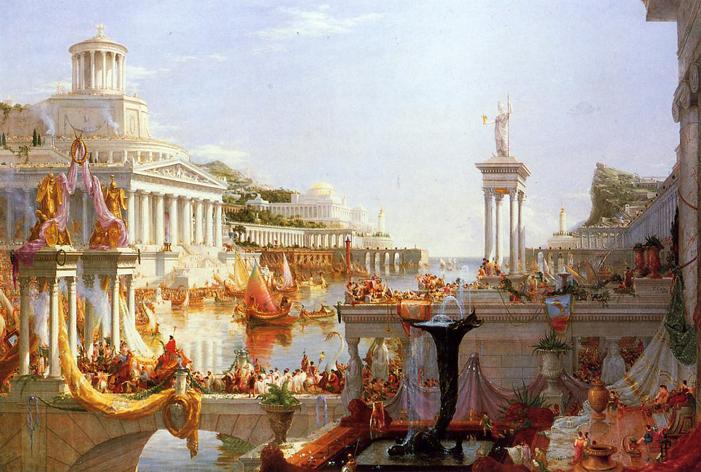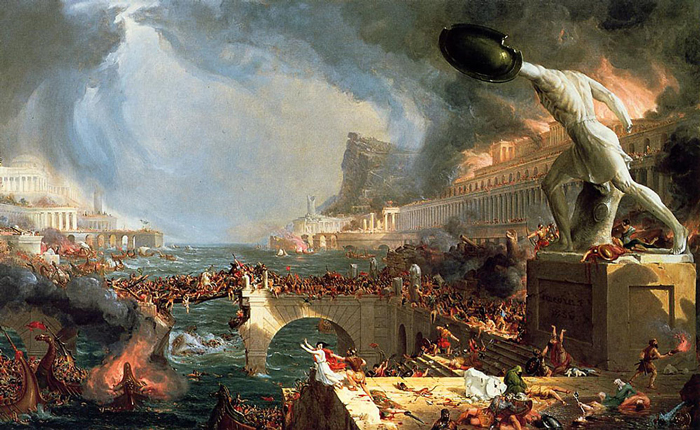The Last Great Social Network
The social layer that replaces Facebook will not look like Facebook.
Facebook hopes to be the last great social network. They want to own the network of connections between people upon which all future applications will be built. Mark Zuckerberg has made this ambition clear:
Our strategy is very horizontal. We’re trying to build a social layer for everything. Basically we’re trying to make it so that every app everywhere can be social whether it’s on the web, or mobile, or other devices. So inherently our whole approach has to be a breadth-first approach rather than a depth-first one.
Facebook rose to dominance as an application running in a web browser on desktop computers, but recently consumer attention has shifted to mobile apps on iOS and Android. This shift is not unique, but rather simply the most recent disruption in a long history of evolving communication technologies. It’s useful to think of this stack of technologies as consisting of four distinct layers1:
- Data networks: satellites, telephone wires, mail trucks
- End-user hardware: mobile phones, desktop computers, rotary telephones
- Operating systems: iOS, Android, Mac OS X, Windows, web browsers
- Applications: Facebook, MySpace, GMail, iMessage
As an application, nine-year-old Facebook has struggled to adapt to the shift from web browsers to mobile phones. It acquired photo-sharing app Instagram to strengthen its mobile presence, yet other competitive mobile apps have continued to grow exponentially: users of two-year-old Snapchat now send 200 million photos per day, and users of four-year-old WhatsApp send 10 billion messages per day2. Can Facebook successfully transition its application to mobile, and either defeat or pay off3 these barbarians at its gates? Must they keep up with every new application-layer innovation? Or is there another strategy?
Alternatively, Facebook can try to become the social layer that Zuckerberg described. If Facebook establishes itself as a new layer between the OS and application layers, then former competitors in the application layer would be reliant on Facebook for the social graph, and Facebook would be protected.
This strategy makes Facebook vulnerable in a variety of other ways, however. First, it is uncommon for any single company to have a monopoly spanning an entire layer. Microsoft Windows, for example, succeeded in monopolizing the desktop OS market, but innovation moved to the web browser. A second example is Apple’s iOS, which had a monopoly in the mobile OS market until Google succeeded in building Android into a viable competitor; this would not have been possible without the help of mobile operators, device manufacturers, developers, and consumers who understood that it was in their interests to cooperate against the iOS monopoly.
Facebook, similarly, faces the cooperative efforts of Twitter, Tumblr, Google, and others who are wary of giving Facebook too much control. Facebook wants all applications to rely on them for their social graph, but it is difficult for Facebook to prevent those companies from leveraging that graph to create a competing social layer. As a result, Facebook encourages smaller applications to use their platform, but restricts access for larger companies. By restricting access, however, Facebook also forces those companies to seek alternative social layers or build their own, thus strengthening competitors. Facebook’s social layer monopoly is further destabilized by the ease with which users can rely on multiple social graphs simultaneously, in contrast to how inconvenient it is for them to use multiple data networks, hardware devices, or operating systems.
Even if Facebook is able to weather the challenges against its monopoly from competitors in the application layer, it faces even more disruptive and inevitable changes in the underlying data network, end-user hardware, and operating system layers upon which this social layer is built. Facebook still rallies behind the cry, “this journey is 1% finished,” and this is true partially because the underlying communication technologies are constantly evolving. There is nothing unique about the ongoing shift in consumer attention from desktop to mobile, and this constant evolution ensures that neither Facebook nor any other single company will own this social layer indefinitely and be the last great social network. Examples of previous disruptive technologies include:
- Telegraphs, a network-layer technology that created many new opportunities for telegraph operators, but hurt the steam ship operators carrying letters across the Atlantic.
- 3G data networks, a network-layer technology that enabled users of WhatsApp and other messaging applications to bypass the exorbitant SMS fees charged by mobile operators.
- Cell phone cameras, a hardware-layer technology that enabled users to share single photos as they were taken, rather than wait until they were at a computer to upload an album, thus altering the market for photo-sharing applications.
- Address book APIs, an OS-layer technology that let applications request access to the contacts on a user’s device, and then match those names/emails/phone numbers with other uploaded address books to automatically find the new user’s friends, thus undermining Facebook’s monopoly on the social graph4.
In each case the changes in underlying technology enabled new consumer behaviors and disrupted old monetization strategies, and it’s difficult for established companies to anticipate these changes and execute accordingly. For example, the current mobile devices are certainly not the apex of communication technology. Regardless of the whether Google can foster healthy social conventions around Glass, it’s clear that we will have wearable communication devices, and that those devices will enable yet-to-be-imagined user experiences in both the social and application layers. There will be many future technologies after Glass at the network, hardware, and OS layers, and each technology will destabilize these higher layers in which Facebook has built its empire and create new opportunities in undeveloped territory.
This recurring rebirth of the technological landscape is related to Clay Christensen’s Innovator’s Dilemma: established companies are vulnerable to smaller companies with disruptive and low-margin technologies that, over time, become profitable and overtake those of the established companies. Should Facebook spend resources developing a new social layer (perhaps enabled by passive data collection from wearable devices like Glass), and risk being too early or building the wrong thing? Or should they wait until the market is established and the interaction paradigms proven, and risk being too late? The barbarians are independent, so each can try a different approach, but a sprawling empire must choose its strategies more carefully.
Furthermore, each product that Facebook builds makes it more difficult for them to add new products at either the social or application layers, both from the perspective of the organization (more teams with vested interests, more products to support/integrate) and the users (more confusing user experiences, more complicated relationships with the brand). Decommissioning old products is difficult for similar reasons, and Facebook can’t rely on network effects between users to protect its borders — Albert Wenger from Union Square Ventures has said that network effects “work very well on the way up, but they also work very well on the way down.”
These questions are not particular to Facebook and its products and strategies, but rather are fundamental to the market for communication technology. Facebook, mired by their secrets and moored by a billion users clicking on advertisements and Like buttons, will not be the last great social network5. Nor will Facebook be the second-to-last great social network — whatever company comes next will face all of the same challenges, and will eventually be replaced by a new social layer for the same reasons. As Zuckerberg said when asked if mobile phones were the future of Facebook, “They’re the future for now, but nothing is the future forever.”
The only question is when. Each new great social network will look different from the previous great social network, because they will be built on a different stack of technologies. Each new great social network will be great for us, the users, because they will bring us ever closer to people who are far away.
The paintings depict neither Facebook nor Ancient Rome (the last great empire?), but rather an imaginary city. Titled The Consummation of Empire, Destruction, Desolation, The Savage State, and The Arcadian or Pastoral State, respectively, they were painted by Thomas Cole from 1833-36 as part of his five-part series The Course of Empire.
-
The layer terminology was inspired by Steve Cheney’s differentiation between application and infrastructure layers in Google Voice and FaceTime – Why the Carriers Are Losing Their Voice, but there are also clear similarities to the seven-layer OSI model (which does not refer to a burrito). Note that the layers described above — data networks, end-user hardware, operating systems, and applications — may be merged or missing in some communication technologies (such as hand-written letters), or duplicated in others (rich web applications like Facebook treat the browser as an OS, even though there is also a host OS).↩
-
There are many messaging apps similar to WhatsApp, including: WeChat, Line, Kakao Talk, Kik, Hike, Path, and MessageMe.↩
-
Snapchat is currently valued at $860 million, and WhatsApp is perhaps worth $1.1 billion, so Facebook could probably just buy them both and be done with it… but they cannot afford to do that with every successful competitive app forever. Furthermore, just as Facebook declined early acquisition offers, these new companies may simply be unwilling to sell at a reasonable price.↩
-
Address book matching has been around for a while, but has recently become increasingly common. It was perhaps pioneered by Kik, and Path was fined by the FTC for automatically collecting this data. Josh Miller has written more recently about this new social graph portability here.↩
-
Facebook may still make a lot of money for its employees and investors, of course, and might never disappear completely.↩
Thanks to @jorgeo and @ninakix for their help with this post!




